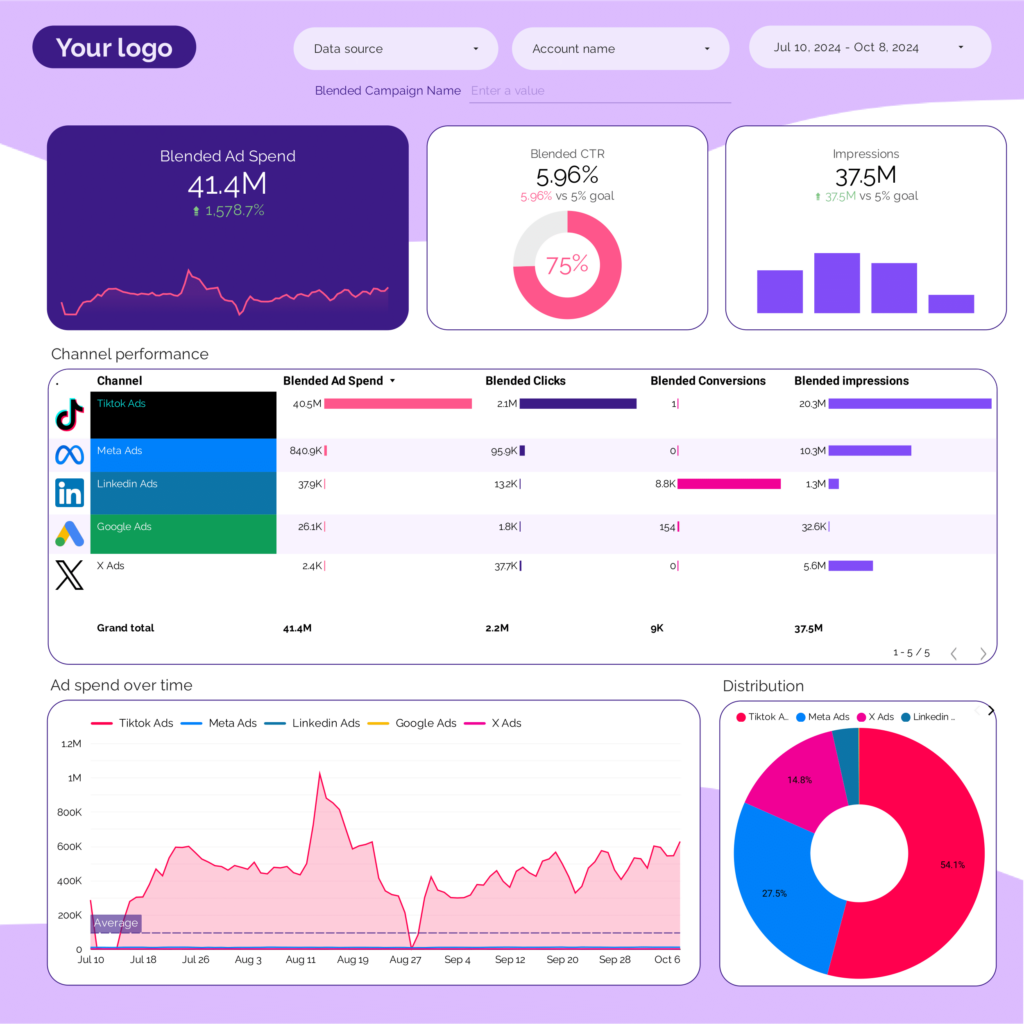A PPC multi-channel report should include the following elements:
1. Campaign Name
2. Date
3. Impressions
4. Clicks
5. Ad Spend
6. CTR (Click-Through Rate)
7. CPC (Cost Per Click)
8. Conversions
9. Conversion Rate
10. Facebook Page Likes
11. Google Quality Score
12. LinkedIn Engagement Rate
13. TikTok Video Views
14. Twitter Retweets
Additionally, include specific identifiers and metrics for each platform, such as:
– Facebook Ad ID
– Google Keyword
– LinkedIn Company Name
– TikTok Hashtag
– Twitter Handle
This comprehensive approach ensures a detailed analysis of performance across all channels.
To analyze PPC multi-channel data, follow these steps:
1. **Data Collection**: Gather data from all relevant platforms such as Facebook Ads, Google Ads, LinkedIn Ads, TikTok Ads, and Twitter Ads. Ensure you have metrics like impressions, clicks, ad spend, CTR, CPC, conversions, and conversion rates.
2. **Data Integration**: Combine data from different channels into a single database or spreadsheet for a comprehensive view. Use tools or software that support multi-channel data integration.
3. **Performance Metrics**: Evaluate key performance indicators (KPIs) such as CTR, CPC, conversion rates, and ROI for each channel. Compare these metrics across channels to identify which platforms are performing best.
4. **Segmentation**: Segment data by campaign, date, or audience to understand performance variations. This helps in identifying trends and patterns specific to certain segments.
5. **Channel Comparison**: Analyze the performance of each channel individually and in comparison to others. Look for strengths and weaknesses in each platform’s performance.
6. **Optimization Opportunities**: Identify areas for improvement, such as high CPC or low conversion rates, and adjust strategies accordingly. Test different ad creatives, targeting options, and bidding strategies.
7. **Reporting**: Create visual reports to communicate findings effectively. Use charts and graphs to illustrate performance trends and insights.
8. **Continuous Monitoring**: Regularly monitor and update your analysis to adapt to changes in performance and market conditions.
To build a PPC multi-channel dashboard, follow these steps:
1. **Data Collection**: Gather data from all relevant PPC platforms such as Google Ads, Facebook Ads, LinkedIn Ads, TikTok Ads, and Twitter Ads. Use APIs or data connectors to automate data extraction.
2. **Data Integration**: Consolidate the data into a single database or data warehouse. Ensure that the data is standardized across platforms for metrics like impressions, clicks, ad spend, CTR, CPC, conversions, and conversion rate.
3. **Dashboard Design**: Choose a dashboard tool that supports multi-channel data visualization. Tools like Google Data Studio, Tableau, or Power BI are popular choices.
4. **Metrics Selection**: Decide on the key metrics to display, such as impressions, clicks, ad spend, CTR, CPC, conversions, conversion rate, and platform-specific metrics like Facebook Page Likes, Google Quality Score, LinkedIn Engagement Rate, TikTok Video Views, and Twitter Retweets.
5. **Visualization**: Create visualizations for each metric. Use charts, graphs, and tables to represent data clearly. Include filters for date ranges, campaign names, and platforms to allow for detailed analysis.
6. **Customization**: Customize the dashboard to highlight important insights, such as top-performing campaigns or areas needing improvement.
7. **Testing and Iteration**: Test the dashboard with stakeholders to ensure it meets their needs. Gather feedback and make necessary adjustments.
8. **Automation and Updates**: Set up automated data refreshes to keep the dashboard up-to-date with the latest data.
By following these steps, you can create a comprehensive PPC multi-channel dashboard that provides valuable insights into your advertising performance across different platforms.
A PPC multi-channel dashboard is a tool that aggregates and displays performance data from various pay-per-click advertising platforms such as Google Ads, Facebook Ads, LinkedIn Ads, TikTok Ads, and Twitter Ads. It provides a comprehensive view of key metrics like impressions, clicks, ad spend, CTR, CPC, conversions, and conversion rates across these channels, allowing marketers to analyze and optimize their campaigns effectively.


 Facebook Ads
Facebook Ads Google Ads
Google Ads LinkedIn Ads
LinkedIn Ads TikTok Ads
TikTok Ads Twitter Ads
Twitter Ads Impressions
Impressions